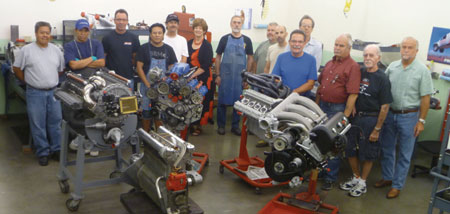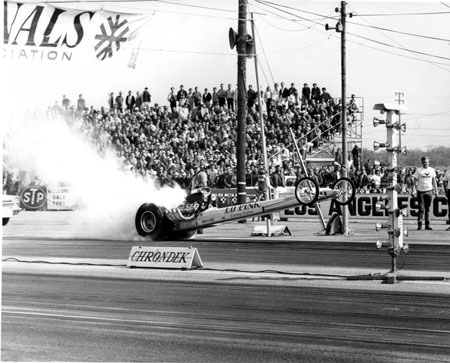The staff of Engine Builder and a panel of industry professionals, including presenting sponsor Driven Racing Oil have selected Ed Pink Racing Engines of Van Nuys, CA, as their choice for the inaugural “Performance Engine Builder of the Year” award – and for good reason. With a body of work going back over 50 years, EPRE has evolved from drag racing specialists known for supercharged nitro-burning Chrysler Hemis to a widely diversified engine emporium with clientele in motorsports venues that range from dirt track bullrings to sports car endurance courses and the wilds of Baja.
Moreover, the business itself exemplifies the qualities of innovation, a sterling reputation, high professional standards, solid management and supportive industry involvement that were key criteria in the award.
Ed Pink opened his engine building shop in 1960, and following a move to a new facility in 1965, opted to promote the business by building his own Top Fuel Dragster. Dubbed “The Old Master,” the car was a dominant force at a number of important events and other racers took note.
Soon, business began to boom. So much so, that it necessitated moving to larger quarters twice in two years, culminating with the facility in Van Nuys that it occupies today (albeit with expanding into the next building and now boasting approximately 12,000 square feet of space).
There was explosive growth in drag racing during the late 1960s and into the 1970s and Ed Pink Racing Engines rode the crest of the wave. It came to be that the majority of drag racing stars from the era, including Don “The Snake” Prudhomme, Don Schumacher, Tom “The Mongoose” McEwen, Kenny Bernstein, Shirley Muldowney, Ed “The Ace” McCulloch and Raymond Beadle (“Blue Max”) relied on “Pink Elephant” power.
However, by 1978 Pink astutely observed that many of the prominent fuel teams were heading toward in-house programs, and consequently broadened the scope of the company by working on Ford Cosworth engines. Soon, there were cars at the Indy 500 with Pink power, including drivers like Al Unser, Sr. and Tom Sneva (the 1983 Indy 500 winner).
Following the Cosworth’s reign at Indy, EPRE focused on the turbocharged Buick V6 and Nissan’s Infiniti program. It was here that Ed came to work with Frank Honsowetz, who was the Infiniti program head, and later joined EPRE as General Manager – a post he holds to this day. Interspersed with the IndyCar activities was a Porsche program with Jim Busby for races like the 24 Hours of Daytona.
Pink engines have also enjoyed considerable success in USAC Midget and Silver Crown competition, with Steve Lewis’ team accounting for no less than ten Midget championships with Ford and Toyota power (and drivers like Tony Stewart, Kasey Kahne and Jason Lefler), plus four Silver Crown sprint car titles with small block Ford power.
In 2008, Ed decided he needed to cut back on his workload and came to sell the business to good customer Tom Malloy. Tom has been a prominent competitor in vintage racing circles, and also has a considerable collection of storied race cars. Frank has the day-to-day managerial responsibility for EPRE, while Pink serves as a consultant: his penchant for thoroughness and attention to detail are woven into the fabric of the shop.
EPRE is organized into a network of divisions: administrative, engineering, quality control, machine shop, assembly, testing, manufacturing and warehousing. A cadre of skilled and dedicated employees is also central to the success of Ed Pink Racing Engines – some of whom have been with the firm for 30-plus years. A mixture of experienced leaders and young, ambitious technicians serves the company well.
The quality of the parts that come in the front door have a significant bearing on the engines that go out the back door of the shop. Accordingly, all supplier components are thoroughly examined to verify that they’re exactly as ordered – much the same as common practice in the aerospace industry.
A precision Brown & Sharp CMM (coordinate-measuring machine) is employed as needed. Years of experience have taught EPRE that what’s in the box isn’t necessarily what the label says it is.
Without question, the strongest suit of Ed Pink Racing Engines is the firm’s ability to tackle virtually any project. At the time of this writing, the cornucopia of engines and cylinder heads being worked on ranged from common small block and big block Chevys, to a Bugatti, MGB, Novi, Offenhauser, Porsche 993, Daimler Hemi V8, and a replica of a converted aircraft engine that won the 1919 Pike’s Peak hill climb in a car.
A couple months from now there are surely to be another group of eclectic projects underway. The oldest engine they’ve ever rebuilt was a 1916 National (was manufactured in Indianapolis), which won a Champ Car race. You can see why walking through the facility would be a memorable experience for any true gearhead, given the wide variety of projects typically in progress.
EPRE has a fully equipped automotive machine shop that can handle every imaginable task; align boring, block decking, boring, honing, etc. And given the lack of commercially available products for many of the rare engines being prepped, EPRE is adept at making fixtures, torque plates, etc. as required.
Testing is an area where EPRE has considerable expertise, as you would expect of a firm that’s done a massive amount of R&D for contract racing programs, development work for NASCAR, as well as Ford, Toyota and Nissan.
The company operates two sophisticated dyno cells that utilize modified Heenan Froude dynamometers and state-of-the-art data collection systems. There is also a complete Spintron test cell for analyzing valve train components. Other test equipment includes fuel, oil and air flow benches, as well as a unique ignition testing device.
Attention to detail in all facets of engine building – from determining what components are best suited to the project to precise and methodical assembly – are hallmarks of EPRE. This is reflected in every engine project that comes in the door, and is carefully documented and moved through the shop with special dedicated parts carts.
In addition to building engines, EPRE has come to manufacture a variety of specialized components that meet the firm’s high standards. An in-house engineering team utilizes the latest CAD solid modeling and three-dimensional software for designing, and the company has equipment that ranges from numerically controlled mills and lathes to a Haas CNC vertical machining center.
A number of the special components used by EPRE are available commercially. These include dry sump oil pumps, oil and fuel filters, and water pumps. The ultra-compact oil pumps feature a twin-lobe rotor design that has been optimized through extensive flow bench, dyno and on-track testing. A unique feature of the pump is a large capacity internal collector manifold that simplifies plumbing by requiring only a single discharge line.
While the company primarily does full-service work for its customer base, Ed Pink Racing Engines also does quite a bit of machine work, Spintron and dyno testing for other builders. It’s the “go to” place for professionals seeking the highest quality workmanship and technical expertise.
One of EPRE’s most recent endeavors is building the engines that are auctioned off on eBay to benefit the SEMA Memorial Scholarship Fund – which aids youngsters seeking a career in the automotive industry (editor’s note: scholarships are offered for university, college and trade school students. Go to www. SEMA.org/scholarships for info).
And it’s this type of involvement that also helps Ed Pink Racing Engines stand out from the crowd, making them a most worthy recipient of Engine Builder’s first Annual “Performance Engine Builder of the Year” award.
Podium Finishers
“We were excited to be part of the Performance Engine Builder of the Year contest with Engine Builder magazine because we are racers ourselves,” explains Lake Speed from Driven Racing Oil. “We have a passion for racing engines and, way too many times, I think the engine builder is often an underappreciated part of the team – they often get too much of the blame and not enough of the credit for the outcome of the race. This is a great chance to give them some well-deserved credit.”
The 2012 Performance Engine Builder of the Year Award was Engine Builder magazine’s effort to showcase creativity and innovation, training and education, merchandising and promotion, professional standards and conduct, appearance, solid business management, community involvement, business growth, achievement and victories.

 “Engine builders were invited to nominate their own businesses but others were welcome to nominate performance engine building businesses as well,” explains Doug Kaufman, associate publisher/editor of Engine Builder magazine. “The entry process was simple and, frankly, the prizes were pretty spectacular. We believe with Ed Pink Racing Engines, as well as our other top finishers, we were able to highlight excellence.”
“Engine builders were invited to nominate their own businesses but others were welcome to nominate performance engine building businesses as well,” explains Doug Kaufman, associate publisher/editor of Engine Builder magazine. “The entry process was simple and, frankly, the prizes were pretty spectacular. We believe with Ed Pink Racing Engines, as well as our other top finishers, we were able to highlight excellence.”
Jeff Taylor Performance of Sellersburg, IN was named second-place finisher in the 2012 contest. “I give every customer my best workmanship and never ship anything that does not meet my meticulous standards,” says Jeff Taylor. “My philosophy is you have to have horsepower to win and if you send an engine out that doesn’t make power on the dyno it will not make power where it counts on the track. Furthermore, if it isn’t meeting our standards, the engine stays at our shop until it meets our expectations.”
Taylor says he specializes in building Chevy engines for NHRA?Competition Eliminator, Super Stock and Stock classes as well as other Super classes. However, the shop has seen great success with engines for circle track and road course racing, including the Camaro Cup Series competing in Sweden.
For more information, visit taylor engines.com.
Like Ed Pink and Jeff Taylor, our third-place finisher believes diversity is a key asset to success. Brad Lagman, from QMP?Racing Engines in Chatsworth, CA, says “I can’t say we specialize in one particular engine. We do a lot of LS?stuff and Ford Modular engines, as well as a lot of higher end street engines, some boat engines and racing engines for NHRA, WCCH and NMCA?competitors. We do just about everything under the sun.
Lagman’s shop is successfully building engines for customers and offers excellent outside machining services to other engine builders as well. “This makes up about half of our business,”?Lagman says. “We have the best equipment out there so we can do the best job for our customers.”
For more information, visit qmpracing.com.
Information about the 2013 Performance Engine Builder of the Year Award, again sponsored by Driven Racing Oil, will be announced soon in the pages of Engine Builder magazine and at topperformanceshop.com. Prizes will be awarded during the Performance Racing Industry Trade Show, which will make its return to Indianapolis, IN,?December 12-14, 2013.

 “Engine builders were invited to nominate their own businesses but others were welcome to nominate performance engine building businesses as well,” explains Doug Kaufman, associate publisher/editor of Engine Builder magazine. “The entry process was simple and, frankly, the prizes were pretty spectacular. We believe with Ed Pink Racing Engines, as well as our other top finishers, we were able to highlight excellence.”
“Engine builders were invited to nominate their own businesses but others were welcome to nominate performance engine building businesses as well,” explains Doug Kaufman, associate publisher/editor of Engine Builder magazine. “The entry process was simple and, frankly, the prizes were pretty spectacular. We believe with Ed Pink Racing Engines, as well as our other top finishers, we were able to highlight excellence.”














